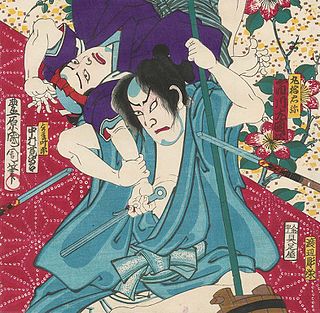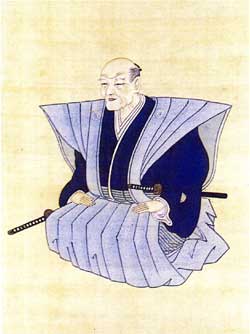Related Research Articles

Emperor Kōmei was the 121st Emperor of Japan, according to the traditional order of succession. Kōmei's reign spanned the years from 1846 through 1867, corresponding to the final years of the Edo period.

Ashikaga Yoshiaki was the 15th and final shōgun of the Ashikaga shogunate in Japan who reigned from 1568 to 1573. His father, Ashikaga Yoshiharu, was the twelfth shōgun, and his brother, Ashikaga Yoshiteru, was the thirteenth shōgun.

Bunka was a Japanese era name after Kyōwa and before Bunsei. The period spanned the years from January 1804 to April 1818. The reigning emperors were Kōkaku-tennō (光格天皇) and Ninkō-Tennō (仁孝天皇).
Metsuke (目付) were the censors or the inspectors of Tokugawa shogunate. They were bakufu officials ranking somewhat lower than the bugyō. The metsuke were charged with the special duty of detecting and investigating instances of maladministration, corruption or disaffection anywhere in Japan, and particularly amongst the populace having status below the daimyō.

Sakai Tadayo was a Japanese daimyō of the Sengoku period, and high-ranking government advisor, holding the title of Rōjū, and later Tairō.

Doi Toshikatsu was a top-ranking official in Japan's Tokugawa shogunate during its early decades, and one of the chief advisors to the second Tokugawa shōgun, Hidetada.
Chaya Shirōjirō (茶屋四郎次郎) was the name of a series of wealthy and influential Kyoto-based merchants who took part in the red-seal trade licensed under the Tokugawa shogunate. Members of the Chaya family, they were also centrally involved in the country's production and trade in textiles. Along with the Suminokura and Gotō families, the Chaya were one of the top merchant families in Edo period Kyoto.
Hotta Masatoshi was a daimyō in Shimōsa Province, and top government advisor and official in the Tokugawa shogunate of Japan. He served as rōjū to shōgun Tokugawa Ietsuna from 1679–80, and as Tairō under Tokugawa Tsunayoshi from the 12th day of the 11th lunar month of 1681 until his death on 7 October 1684.
Sakai Tadakiyo, also known as Uta-no-kami, was a daimyō in Kōzuke Province, and a high-ranking government advisor and official in the Tokugawa shogunate of Japan.

Marubashi Chūya was a rōnin from Yamagata, and instructor in martial arts and military strategy, most famous for his involvement in the 1651 Keian Uprising which sought to overthrow Japan's Tokugawa shogunate. He is said to have been a man of great strength and good birth whose distaste for the shogunate stemmed primarily from a desire for revenge for the death of his father, killed by the shogunal army at the 1615 siege of Osaka. The identity of his father is not clear, but may have been Chōsokabe Motochika.

Sakai Tadakatsu was a Sengoku period Japanese samurai, and early Edo period daimyō and served in several important positions within the administration of the Tokugawa shogunate.
The Buke shohatto, commonly known in English as the Laws for the Military Houses, was a collection of edicts issued by Japan's Tokugawa shogunate governing the responsibilities and activities of daimyō and the rest of the samurai warrior aristocracy. These formed the basis of the bakuhan taisei which lay at the foundation of the Tokugawa regime. The contents of the edicts were seen as a code of conduct, a description of proper honorable daimyō behavior, and not solely laws which had to be obeyed. By appealing to notions of morality and honor, therefore, the shogunate was able to see its strictures followed despite its inability to enforce them directly.

Nagasaki bugyō (長崎奉行) were officials of the Tokugawa shogunate in Edo period Japan. Appointments to this prominent office were usually fudaidaimyōs, but this was amongst the senior administrative posts open to those who were not daimyōs. Conventional interpretations have construed these Japanese titles as "commissioner", "overseer" or "governor".

Sado bugyō (佐渡奉行) were officials of the Tokugawa shogunate responsible for administration of the mining operations at Sado.
Kanjō-bugyō (勘定奉行) were officials of the Tokugawa shogunate in Edo period Japan. Appointments to this prominent office were usually fudai daimyōs. Conventional interpretations have construed these Japanese titles as "commissioner" or "overseer" or "governor".
Osaka machi-bugyō were officials of the Tokugawa shogunate in Edo period Japan. Appointments to this prominent office were usually fudai daimyō, but this was amongst the senior administrative posts open to those who were not daimyō. Conventional interpretations have construed these Japanese titles as "commissioner" or "overseer" or "governor".
Edo machi-bugyō (江戸町奉行) were magistrates or municipal administrators with responsibility for governing and maintaining order in the shogunal city of Edo. Machi-bugyō were samurai officials of the Tokugawa shogunate in Edo period Japan. Appointments to this prominent office were usually hatamoto, this was amongst the senior administrative posts open to those who were not daimyōs. Conventional interpretations have construed these Japanese titles as "commissioner", "overseer" or "governor."

Suminokura Ryōi was a merchant and shipper of Edo period Kyoto.
Daigaku-no-kami (大学頭) was a Japanese Imperial court position and the title of the chief education expert in the rigid court hierarchy. The Imperial Daigaku-no-kami predates the Heian period; and the court position continued up through the early Meiji period. The title and position were conferred in the name of the Emperor of Japan.

Zeniya Gohei was a Japanese merchant and engineer in the Edo period.
References
- Cullen, Louis M. (2003). A History of Japan, 1582-1941: Internal and External Worlds. Cambridge: Cambridge University Press. ISBN 9780521821551; ISBN 9780521529181; OCLC 442929163
- Sansom, George Bailey. (1963). A History of Japan: 1615-1867. Stanford: Stanford University Press. OCLC 36820228